Quick Meals
Sometimes we eat to fuel up; sometimes we eat to warm up. And then there are times we eat just because it makes us feel good. Whatever the motivation, a hot meal can really hit the spot, especially if your dining room is the cockpit of a kayak or while lounging alongside a campfire. While some might be content to ward off hunger pangs with a high-energy food bar, others might opt for a serving of chicken with pasta and tomato sauce – stove top hot and ready to eat in ten minutes! Sounds yummy.
There are several nutritional factors to consider when choosing a particular brand. One way to measure the value of a meal is to check the number of calories per serving. Here's a very general comparison of entrees taken from several leading brands:
| Chicken | Beef | Vegetable | Pasta | Dessert | Energy Bar | |
| Calories | 210 to 560 | 250 to 630 | 200 to 550 | 210 to 520 | 110 to 350 | ~250 |
| Sodium (mg) | 115-2,120 | 710-2,390 | 170-1,740 | 170-1,250 | 35-880 | 20-250 |
- The recommended daily sodium intake for an average adult is about 2,300 mg. (about a teaspoon). Compiled from "Food Product Information" sheet provided by REI. - The U.S. Dept of Health and Human Services, Dietary Guidelines for Americans states a suggested daily calorie intake for a "moderately active", 19-30 yr. Male 2,600 to 2,800. The suggested intake for a Female is 2,000-2,300.
Here's a look at the range of an assortment of "ready-to-eat/self-heating" meals on the market today.
MRE's – Meals Ready to Eat:
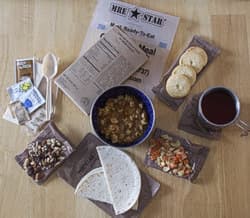
Historically, in times of conflict, "C-Rations" were the common form of field sustenance – in an environment where it was hard to get and keep fresh foods. Also, smoke and the light of cooking fires meant revealing oneself to the enemy. Later, improved versions ultimately led to government issued MRE's – Meals Ready to Eat. The foods offered were either pre-cooked or dehydrated: from chipped beef or chicken, to side items such as wafers and granola mixes to a packet of candy (M&Ms seem to be the candy of choice in military MREs.). Couple the food with utensils, salt/pepper packets and a tiny napkin and one had a full setting for meal that could be eaten cold from the packet, or via warming over a heat source. If for some reason you decided not to consume all of your MRE, not to worry, they have a shelf life of years!
I have an MRE packet I was issued in Fairbanks in 1977! Yup, over thirty years ago – and I still have it. I had resisted opening it for years prior to writing this particular article. I gave in and inspected the contents. "Corn Beef Hash" in an airtight, foil pouch, on a shelf for over 30 years! Hard to imagine being hungry enough to try that. I haven't yet. Yea, that's right – food wuss. I did try the sealed wafer. It was bland, flakey and... dry. I don't think that even right after it was cooked that it tasted any better. It was at least still edible after all those years!
A typical MRE usually offers the consumer about 1200-1400 calories. For military purposes they are meant to be consumed as part of diet totally 2800 to 3600 calories! Lots of energy for soldiers in war zones.
Today's MRE comes with a chemical heat generating pouch that is activated by adding a small amount of ordinary tap water to a plastic cooking envelop. Since the food is already cooked, these meals are simply heated to approach stove-top temperatures of yumminess. I looked at two popular brands:
MRE STAR: I tried to compare chicken dinners with other chicken dinners of the same type (pasta vs. pasta). MRE STAR is a full meal packet that has flavors comparable to all the others I tried. I never found one to rave about but never found any I couldn’t live on satisfyingly for several days, either. MRE STAR offers the typical varieties of beef/chicken/pasta/veggie entries. Supplemental food includes a drink powder mix, wafer/cracker; peanut butter, granola and a snack complement. The utensil packet is similar to all: plastic spoon, fork, salt/pepper/seasoning packets, sugar/coffee/creamer and napkin. Average cost = $6.50/based on a case of 12.
EVERSAFE: Another leading supplier to the military, these meals also passed the “eat again” test. Whether my piece of chicken is a cube or a free-form chunk, I want it to look and taste like chicken. Like the MRE Star, EVERSAFE meals are all high in sodium, too, some up to 60% of recommended levels in just one meal. That being said, none of these were too salty to the taste – or overly flavorful or spicy at all. Tomato sauces had a touch of tomato tang, but white gravies in chicken dishes were pretty bland for my taste buds. That said, just bring along your camping spice kit (you do have one, don’t you?) and doctor it up to your levels of tastiness. Average Cost: +/- $5.50; in case lots.
One big difference between the MRE's of old and the other "quick meals" of today seems to be that MRE's are considered complete, full calorie meals whereas the heat-and-serve pouch meals are convenient and fast but rarely have that much caloric value, some offering few calories but at 3-4 times the cost.
Neither of these MRE's includes a water packet for activating the heating packet. A positive note on that is that since the water does not come in contact with the food, you can use water right out of the river or lake.
Self heating, one-dish, pre-cooked meals:
By my interpretation, these truly are self-heating quick meals! The entrée (which is already completely cooked) is sealed in a small plastic dish which is more firm that the foil packets of the MRE and hence easier to handle/eat right from the carton. Also, these kits come with the exact amount of water you will need to activate the heater packet. The water is nicely packaged in a pouch- ready to pour. Tastiness was a step up towards “flavorful” but still could have been kicked up a notch – or three!
- LA BRIUTE
If the cover shot counts, looks alone would make my mouth water at these meals (except the waxy cubes of potatoes (?) on the Salisbury steak meal). They are very easy to prepare: the food is already cooked; it comes in a handy rectangular bowl in which it is heated using the water that is supplied with the kit.
La Briute offers several delectable meat dishes including Chicken Primavera with Noodles, and Vegetarian Honolulu Nuggets with pineapple. You could "cook" one of these up in your cockpit and hardly miss a stroke paddling. Like all others, my taste buds needed more spice/seasoning so I had to add to the mix. Be forewarned, these babies get hot! Very hot, right from the get-go! It takes about 10 minutes to adequately warm the contents. The packet tends to put out heat for several more minutes – enough time to perhaps warm up the toe area of a sleeping bag. Average cost from a variety of website sources: $7.50 to $9.
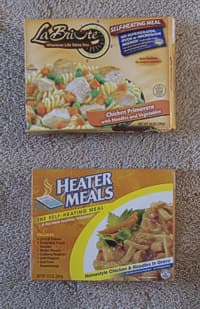
- HEATER MEALS Because their name is what it is, Heather Meals are wide spread throughout the Internet when "self-heating meals" are sought. These are completely self-contained and feature a water packet, "cooking" dish and heater component. Again, a word of caution: rising steam is generated almost instantly – very hot. Meals are warmed up in about 10 minutes.
Heater Meals come in standard entrée offerings in three different storage lives: Heater Meals/2 yr. shelf life; Heater Meals 3/3 yr. Shelf life; and Heater Meals EX with an extended shelf life of 5 years. Longer storage capabilities means slightly higher sodium contents. Generally these contain slightly more sodium.
Entrees included the usual meat choices and veggie/pasta dishes. The flavors were OK, not overly seasoned, but again, all were quite acceptable and easy to enhance either with the basic seasons provided or with your own herb kit. Calories ranged from about 300 to 460; sodium levels were between about 400mg. and 700 mg. Average cost: HM/$4.39; HM3/$5.49; HM-Ex/$4.55 based on a 12-unit case.
Dehydrated, "Just Add Water" Food Entrées
These meals were the most flavorful – and the least "quick"! I compared chicken entrees for my taste testing and found each one slightly unique and all more tasty than all the previous meals. That's not totally surprising since these were also the most sodium laden of the group. The tastiness came partially from the salt that I think might have enhanced other seasonings used for a particular entrée.
All the meals in this group required water from an outside source, a stove or fire for boiling and in some cases additional containers to cook or simmer the packet’s contents (most could be prepared in their own package).
In general, most of these I sampled were double servings. Combining two packets into a two-course entrée is a plus these meals have in common with each other.
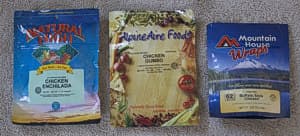
- ALPINE AIRE FOODS Boil water, open pouch, poor in water, wait ten minutes. That's the full run of prepping these handy meals. The choices are basic beef or chicken, veggies or pasta. Noted for their high nutritional content, Alpine Aire packets have a shelf life of up to 15 years! Their Chicken Gumbo tested out to be somewhat spicy with a bit of a salty taste. That’s not surprising since the 279-calorie serving (two per package) had 1,368 mg of sodium! That’s nearly 60% of the daily requirement of salt. The chicken was partnered with lots of rice. Still pretty tasty and plenty to go around. Price range: $7-$8.
- CACHE LAKE'S OUTFITTERS CHOICE
"Quick" in the sense that all the food is pre-prepared and ready to cook. These meals are very tasty but require water, heat and a pot to prepare entrées in. Since one of the advantages of these quick meals is to enjoy foods that might otherwise perish on a trip for lack of proper storage, the time it takes to go through Cache Lake's process is not so terrible. Whereas some freeze-dried foods merely need hot water to soak in inside their pouch, the Cache Lake foods must be boiled in a pot for a certain length of time. Still, if you were camping and wanted meals beyond what your storage limitations were, these meals might be just the ticket.
I tried their chicken, veggies and gravy with mashed potatoes and found it to be quite flavorful and a genuine stick-to-your-ribs treat. It stayed hot longer than did the self-heating types. Its down side could be 1,056 mg. of sodium from the scant 284 calories.
A class-act favorite that could be "cooked" with any of these meals is Cache Lake’s Fryin’ Pan Bread. It’s awesome. Mix the dough, flatten it into frying pan and get a soft, tasty, steaming pan bread within a few minutes! Absolutely delicious! Costs range from $6-$9.
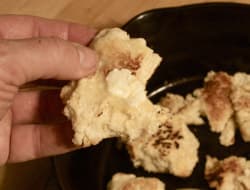
- MARY JANES FARM
These meals deliver taste! Of course, they were designed, it seems, merely to take the burden off all the kitchen prep work that goes into making a full-course dinner. And they are made with organic ingredients!
I tried a black bean and rice offering laced with sharp cheddar cheese and sweet red peppers. It had a very homey taste. Sodium level was at 680 mg at 380 calories but I didn’t have another similar entrée to compare it to. If you saved the tortillas that come in some MRE kits, you could combine the two into a satisfying treat. That’s another benefit of these meals; many of them can be combined to raise the calorie intact (at the risk of salt overdose perhaps). These meals are rather expensive ($9.25 for the black beans). Costs range from $8-$13+.
- MOUNTAIN HOUSE
We've been comparing dinners so far. I tried this brand's breakfast for a change and was surprisingly pleased. I am not much of a breakfast person but was satisfied with the flavor of their scrambled eggs and bacon. Cache Lake's eggs and bacon was similar but they use bacon bits instead of Mountain House’s - real bacon and I could taste the difference.
Like all the others, some meals are frugal with salt while others pack it in – in some cases with three times more sodium than calories. They offer a variety of entrees in good portions. I actually tried their freeze-dried ice cream sandwich. I was amazed at the rich, true flavor. The texture was very weird but it sure tasted just like the ice cream. Costs range from about $5-$6.50.
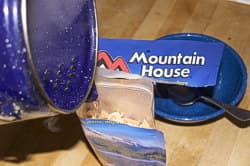
- NATURAL HIGH/RICHMOOR Very similar to the others, perhaps not as pricey. I tried a Chicken Enchilada mix and found it to be adequately spicy and plenty to eat (it served 2). Natural High claims to have no preservatives, no artificial colors, flavors or additives. That seemed to be evident by its list of ingredients; the only brand of all those tested that didn’t list any chemicals at all (Mary Janes Farm lists "enzymes" {vegetable rennet}). These meals seem to have a little less sodium than others, too. Costs average about $6.75 for single course meals.
There are a few minor variances in the taste among similar entrees by different brands. A prudent shopper would be wiser to consider personal nutritional needs such as carbs or proteins, and certainly the amount of sodium you should be consuming. As far as prep goes, clearly the quickest/easiest ones are those with the required water already included (Heater Meals/LaBriute). The most flavorful are those that require some "cooking" time in pots (Cache Lake) and the most diverse are those that offer supplemental foodstuff and snacks (MRE Star/Eversafe).
With the exception of the Mexican entrees, all brands could use some help from a personal herb/seasoning kit.
Quick perk, serious refueling or simply the novelty of having a hot meal without ever leaving your boat, these "quick" meals help take the edge off of hunger. Bon appetite, matey!
Related Articles
Who says that cooking with herbs should be reserved only for home cooks and that campers shouldn't take…
Growing up in a big multiethnic city I often shared meals with the family of one of my best friends,…
Because I come from a northern region well known for its maple syrup production, nothing represents…
Nothing says Christmas more than rich, dark cakes loaded with candied fruit, nuts and spices that bring…
